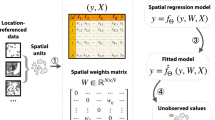Abstract
Natural numerical networks on directed graphs as a new supervised deep learning PDE-based classification algorithm are proposed in this work. The Natural numerical network (NatNet) is based on a forward-backward diffusion model, where the points of the given clusters are attracted together by the forward diffusion, and in contrast, the backward diffusion repulses points of different clusters from each other. First, the network is trained on the labelled data to achieve the highest possible accuracy on the learning dataset. Then, the method is applied to the classification of Sentinel-2 satellite optical data to automatically identify the protected oak habitat in Western Slovakia due to its threatened status. To that goal, the relevancy map, one of the outputs of the Natural numerical network, is created efficiently; its construction is significantly speed up thanks to the new NatNet formulation on directed graphs.
Supported by grants APVV-19-0460, VEGA 1/0436/20 and ESA contract 4000140486/23/NL/SC/rp.
Access this chapter
Tax calculation will be finalised at checkout
Purchases are for personal use only
Similar content being viewed by others
References
Bang-Jensen, J., Gutin, G.R.: Digraphs: Theory, 2nd edn. Algorithms and Applications. Springer-Verlag, London (2010)
Bertozzi, A.L., Flenner, A.: Diffuse interface models on graphs for classification of high dimensional data. SIAM Rev. 58(2), 293–328 (2016). https://doi.org/10.1137/16M1070426
Böhm, J.N., Berens, P., Kobak, D.: Attraction-repulsion spectrum in neighbor embeddings. J. Mach. Learn. Res. 23(95), 1–32 (2022)
Chang, B., Meng, L., Haber, E., Ruthotto, L., Begert, D., Holtham, E.: Reversible architectures for arbitrarily deep residual neural networks. In: 32nd AAAI Conference on Artificial Intelligence, AAAI 2018. vol. 32, pp. 2811–2818 (April 2018), https://ojs.aaai.org/index.php/AAAI/article/view/11668
Cheng, K., Wang, J.: Forest type classification based on integrated spectral-spatial-temporal features and random forest algorithm-a case study in the qinling mountains. Forests 10(7), 559 (2019). https://doi.org/10.3390/f10070559
Earth Observing System: Normalized difference vegetation index. https://eos.com/ndvi/ (2020)
European Environmental Agency: The natura 2000 protected areas network. https://www.eea.europa.eu/themes/biodiversity/natura-2000/the-natura-2000-protected-areas-network (2020)
European Space Agency: Sentinel 2. https://sentinel.esa.int/web/sentinel/missions/sentinel-2/data-products (2020)
Friedman, J., Tillich, J.P.: Calculus on graphs. CoRR cs.DM/0408028 (2004)
Haber, E., Ruthotto, L.: Stable architectures for deep neural networks. Inverse Probl. 34(1) (2018). https://doi.org/10.1088/1361-6420/aa9a90
He, K., Zhang, X., Ren, S., Sun, J.: Deep residual learning for image recognition. In: CVPR, pp. 770–778 (June, 2016). https://doi.org/10.1109/CVPR.2016.90
Jolliffe, I.T.: Principal Component Analysis. Springer-Verlag, New York, 2nd edn. (2002). https://doi.org/10.1007/b98835
Mikula, K., Kollár, M., Ožvat, A.A., Ambroz, M., Čahojová, L., Jarolímek, I., Šibík, J., Šibíková, M.: Natural numerical networks for natura 2000 habitats classification by satellite images. Appl. Math. Model. 116, 209–235 (2023). https://doi.org/10.1016/j.apm.2022.11.021
Mikula, K., Ramarosy, N.: Semi-implicit finite volume scheme for solving nonlinear diffusion equations in image processing. Numer. Math. 89(3), 561–590 (2001)
Mikula, K., et al.: Naturasat-a software tool for identification, monitoring and evaluation of habitats by remote sensing techniques. Remote Sens. 13(17) (2021). https://doi.org/10.3390/rs13173381
Noi, P.T., Kappas, M.: Comparison of random forest, k-nearest neighbor, and support vector machine classifiers for land cover classification using sentinel-2 imagery. Sensors (Switzerland) 18(1), 18 (2018). https://doi.org/10.3390/s18010018
Rencher, A.: Methods of Multivariate Analysis. Wiley-Interscience (02 2002). https://doi.org/10.1002/0471271357
Waśniewski, A., Hoscilo, A., Zagajewski, B., Mouketou-Tarazewicz, D.: Assessment of sentinel-2 satellite images and random forest classifier for rainforest mapping in gabon. Forests 11(9), 941 (2020). https://doi.org/10.3390/f11090941
Author information
Authors and Affiliations
Corresponding author
Editor information
Editors and Affiliations
Rights and permissions
Copyright information
© 2023 The Author(s), under exclusive license to Springer Nature Switzerland AG
About this paper
Cite this paper
Mikula, K., Kollár, M., Ožvat, A.A., Šibíková, M., Čahojová, L. (2023). Natural Numerical Networks on Directed Graphs in Satellite Image Classification. In: Calatroni, L., Donatelli, M., Morigi, S., Prato, M., Santacesaria, M. (eds) Scale Space and Variational Methods in Computer Vision. SSVM 2023. Lecture Notes in Computer Science, vol 14009. Springer, Cham. https://doi.org/10.1007/978-3-031-31975-4_26
Download citation
DOI: https://doi.org/10.1007/978-3-031-31975-4_26
Published:
Publisher Name: Springer, Cham
Print ISBN: 978-3-031-31974-7
Online ISBN: 978-3-031-31975-4
eBook Packages: Computer ScienceComputer Science (R0)




